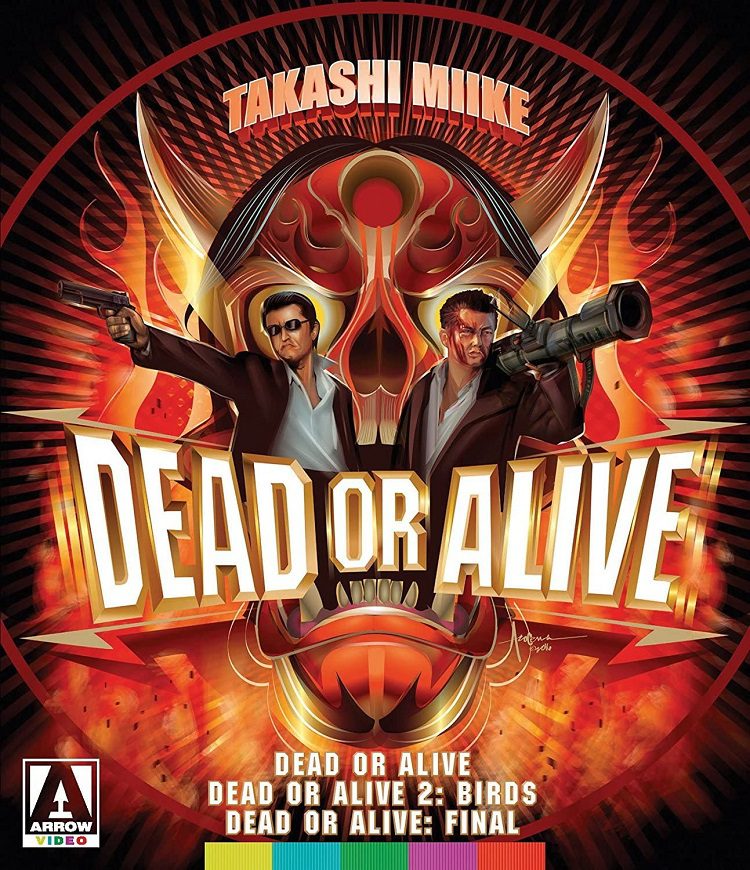
Takashi Miike is an insanely prolific (and possibly just straight up insane) Japanese director. He has 102 directorial credits on IMDB since 1991. That’s nearly four film/TV credits per year. While he is mostly known for his extreme horror in the U.S. with secondary acclaim for his Yakuza films, he’s actually an incredibly diverse filmmaker having made comedies, dramas, science fiction, historical epics, and even a family film or two. His best films are both widely loved and criticized for their use of graphic violence and perverse, often extraordinarily sexual sense of humor.
Just to demonstrate how many films Miike has made, Dead or Alive could be considered early Miike and yet he directed 31 films before it. He completed the trilogy in 2002 just three years later yet he’d made 14 other films between them including the sixpart TV show Multiple Personality Detective Psycho.
The Dead or Alive Trilogy is a trilogy mostly in name only. They all star Shô Aikawa and Riki Takeuchi (as different characters each time) and deal with the criminal underworld in Japan, but plot-wise that’s where the similarities end. Yet thematically, and in terms of sheer wacky weirdness, they are all straight-up Miike films.
Dead or Alive begins with what could make for a beginner’s guide to Takashi Miike. It starts with a naked woman falling off a high rise and then hypnotically takes us – via fast cuts and pulsating music – though a hallucinogenic tour of the Japanese underground, which features lots of undulating strippers, a man eating bowl after bowl of noodles, another man snorting a enormously long line of cocaine, and a series of violent murders including two men having some dirty bathroom sex who get it in the back of the head. By the end of the montage, it’s as if Miike is daring the viewers to keep watching.
Plot-wise, the rest of the film is a pretty straight-forward crime drama with a small gang of criminals pitting the Japanese Yakuza against the Chinese Triads for control of the drug trade, and Detective Jojima trying desperately to stop the violence. Basic story aside, Miike fills it with his usual unusualness including a woman taking a bath in her own feces, a dog being prepared to have sex with a woman, and an ending that comes so completely out of nowhere there are thousands of internet posts discussing exactly what it means.
Dead or Alive 2: Birds is rather subdued for a Miike film. Aikawa and Takeuchi once again star but this time they are both contract killers. When one is hired to kill the other, they first discover that they were childhood friends and then travel to the island where they grew up. What follows is as idyllic and sweet natured as Miike has ever been. The two rekindle their friendship and reminisce with others from their small town. Then they decide to form a team and start killing for the greater good. There’s still plenty of gonzo Miike flourishes, like an incredibly sexually charged play put on for children, but the sentimentality can actually be a little bit moving.
Dead or Alive: Final finds out two actors in the near future where after a post-apocalyptic war a fascist dictator forces everyone to take birth-control pills in order to keep total control. In what is either a homage to or a blatant rip-off of Blade Runner, the world is full of replicants – android warriors – and once again their is a face-off between the two sides. Clearly made on the cheap and super-fast, Dead or Alive: Final feels more like a student film channeling Miike than that of a world-renowned cult director, but I guess when you make as many films as Miike does sometimes there just isn’t going to be room to get all the details right.
Video quality for all three films is pretty lackluster. The first two films are manageable but have some pretty variable consistencies in terms of quality, compression elements, and color quality. But the third film looks pretty bad. Arrow even notes this with a title card detailing how there were no high-definition masters ever made. I don’t know how much Arrow is at fault here as the low budgets and video masters of these films were never likely demonstration quality, but they certainly aren’t going to get anybody excited about them now either. Audio quality does better with very serviceable vocals, sound, and scoring on all three films.
Extras are decent but not quite up to the standards one becomes used to with Arrow Video releases. Dead or Alive comes with an audio commentary from Miike biographer Tom Mes; Dead or Alive 2 has a short, archival making of featurette; and Dead or Alive 3 comes with a making-of piece plus some promotional interviews. Each films comes with the usual trailers. It comes in a basic plastic casing with Arrow’s standard reversible sleeve plus a nice booklet with essays on the films. It should be noted that the first two films are placed on a single disk with the third film getting a separate disk.
The Dead or Alive Trilogy is as good a place as any to begin with Takashi Miike. His extreme violence, perverse sense of humor, and almost touching sentimentality are all on display in these films. At his best, Miike proves to be an innovative, exciting director with a unique ability to delve into themes most filmmakers would never touch. At his worst, he comes off as a cheap provocateur out to make a buck off of cheap shocks. Both aspects are on display here. Arrow Video’s release is a nice collection hampered by lackluster video presentations and a disappointing lack of extras.